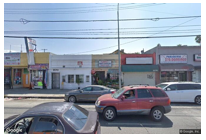CommentsPLATKIN ON PLANNING-City Planning has developed a host of ways to assist real estate developers building for the high end of the real estate market. Their helping hand, though, is based on cheating, and it also hides behind several totally spurious claims. While they don’t yet concede their bait-and-switch approach, their friends, like Senator Scott Wiener, unabashedly support real estate speculators with many outlandish predictions.
According to Wiener and friends, the new market housing will boost transit ridership, reduce residential segregation, slow down gentrification, and meet the housing needs of the homeless, the overcrowded, and the rent-stressed. Since I debunked most of these claims in last week’s CityWatch column, this week I will zero in on the cheating.
City Hall’s first cheating tactic is to rely on inflated population forecasts from the Southern California Association of Governments (SCAG) for the plan horizon years of 2035 or 2040. With these inflated numbers in place, the media and the public are then told that Los Angeles will soon experience another population boom. It must, therefore, loosen up its planning, zoning, and environmental regulations to make sure there is enough housing for these newcomers.
One of the best-known cases of these inflated SCAG population numbers was the General Plan Framework Element, an otherwise exemplary planning document. Based on SCAG’s extrapolation of prior decennial census data, SCAG’s 2010 population forecast for Los Angeles was 4,300,000 people. But, when the Bureau of the Census released its 2010 data, Los Angeles, only had 3,790,000 people. Without any explanation, 500,000 people never materialized.
Despite SCAG’s subsequent silence, it is not hard to figure out why the 2010 numbers were so incorrect, and why SCAG’s 2040 forecasts will suffer the same fate. SCAG’s methodology relies on historical trend data. Since Los Angeles was once a boomtown, it is easy to extend long-term historical trends into the future and predict enormous population growth. Then, when the inevitable mistakes become apparent, there is too much resistance from local municipalities, especially Los Angeles, to make mid-course corrections, explain why the forecast methodology was so flawed, and to detail how it will be corrected in the future. Given this uncertainty and the prominent role of the urban growth machine in local politics, the political winds invariably blow in the direction of inflated population numbers. Boosterism, not sound social science, prevails.
The truth is that is impossible to make accurate long-term population forecasts. This is why State law and professional city planning standards call for rigorous annual plan monitoring, including demographic assumptions, followed by comprehensive plan updates every 10 years. As for local plans, such as LA’s 35 Community Plans, they should be updated every five years, not every 20 years!
(Since City Hall avoids this heavy lifting, the Coalition to Preserve LA has hired a demographic consult to uncover and analyze the missing and much more reliable [i.e., less inflated] short-term population data.)
As for the long-term forecasts, they invariably fail because they are unable to accurately predict the following population variables:
- Global economic booms and busts, such as the Great Recession of 2008-9, sabotage any trend line population projections.
- New technologies, such as streaming video, rapidly change local economies, hiring patterns, and population trends.
- The growth of foreign competition forces American companies to relocate or shut down factories and businesses, creating job loss.
- Changes in laws governing immigration to the United States and forced deportations during the Obama and Trump administrations.
- Revisions to financial regulations in other countries, such as China.
- Political upheavals and war in other countries, especially Africa and the Middle East, force millions of refugees and political asylum seekers to other countries in search of personal safety.
- Climate change.
- Shifting tax and wage laws in different American states.
- Changing urban programs, such as the massive cuts in the US’s social safety net and public housing programs over the past 40 years.
- Fluctuating housing costs in Southern California and in other states.
- Erratic hiring patterns in other states, such as sudden swings in the Bakken fracking areas of North Dakota and Montana.
- Amendments to local plans, zoning laws, and environmental regulations.
- Reduced amounts of and rising costs of raw land, forcing developers to ignore adopted plans and turn to suburban areas and infill development.
Since there is no way to overcome these barriers, local government’s only recourse is to rigorously monitor plans on an annual basis, make mid-course corrections, and then fully update their plans when new decennial census data becomes available. But since this approach to planning conflicts with the business model of real estate speculators, it rarely takes place in Los Angeles.
City Hall’s second cheating tactic is repeated claims that LA’s existing zones and plan designations are not sufficient to meet the housing needs of either current or future residents. But, since City Planning has not prepared any zoning build-out calculations since the early 1990s, this is pure bluster. Their claim also contradicts these early 1990 studies, which concluded that Los Angeles could reach a population of 8,000,000 people based on existing zoning.
These studies, for the AB 283 Zoning Consistency Project and for the General Plan Framework, also indicated that Los Angeles has enough commercially zoned land for all growth scenarios during the next 100 years. The city does not, however, have enough supportive infrastructure and services for this level of development. The barrier to growth, therefore, is insufficient infrastructure and public services, not zoning capacity.
Since the era of AB 283 and the General Plan Framework in the late 1980s and early 1990s, the City’s zoning capacity has actually grown, potentially squeezing infrastructure and services even more. Since every commercially zoned piece of property, as well as most manufacturing zones, can also be used for apartments, and since the RAS zone, the SB 1818 Density Bonus ordinance, and the new Value Capture Ordinance allow developers to increase the height, mass, and number of units in by-right apartment building by 20 percent or more, the claim that LA’s existing zoning is inadequate is even more deceptive than before.
This is, in fact, why the General Plan Framework, repeating housing policies that date back to the Mayor Tom Bradley era, calls for additional housing (if and when it is needed) to be constructed at transit hubs and on long, under-utilized transit corridors. To get a sense of how much unused zoning potential exists at transit centers and transit corridors, the General Plan Framework’s Chapter Two reports,
 “Fewer than five percent of the commercial properties currently allowed to develop at a floor area ratio of 1.5:1 have been developed at this intensity.”
“Fewer than five percent of the commercial properties currently allowed to develop at a floor area ratio of 1.5:1 have been developed at this intensity.”
Anyone who doubts this, only needs to randomly check out any long transit corridor in Los Angeles, such as Pico Boulevard. When they do so, they will see miles of one and two-story buildings, all of which could be replaced by three story apartment buildings. Then, through SB 1818 or soon through the Value Capture Ordinance, developer could build four and five story apartment buildings at these same locations without any zoning or planning waivers. (Photo left: Pico Boulevard is a typical low-rise transportation corridor with vast untapped zoning capacity for housing.)
City Hall’s third cheating tactic is to make sure that the City’s sporadic and superficial plan monitoring process does not measure the public’s need for services and infrastructure, nor the City’s ability to provide these services and infrastructure. Although the programs carefully outlined below describe the required Framework’s monitoring program in detail, City Hall never complied with them:
General Plan Framework Element Policy 42: Establish a Monitoring Program to … assess the status of development activity and supporting infrastructure and public services within the City of Los Angeles. The data that are compiled can function as indicators of (a) the rate of population growth, development activity, and other factors that result in demands for transportation, infrastructure, and services; (b) location and type of infrastructure investments and improvements; and changes to the citywide environmental conditions and impacts documented in the Framework Element environmental database and the Environmental Impact Report.
General Plan Framework Element Policy 43: Prepare an Annual Report on Growth and Infrastructure based on the results of the (General Plan) Monitoring Program, which will be published at the end of each fiscal year and shall include information such as population estimates and an inventory of new development. This report is intended to provide City staff, the City Council, and service providers with information that can facilitate the programming and funding of capital improvements and services. Additionally, this report will inform the general plan amendment process. Information shall be documented by relevant geographic boundaries, such as service areas, Community Plan Areas, or City Council Districts.
Without this monitoring information carefully collected, assessed, and then applied to the General Plan, as well as amendments to the General Plan and other discretionary actions, the City of Los Angeles is flying blind. It is, essentially, a hulking mass of thousands of separate market-driven real estate projects, matched with siloed public agencies whose only focus is their turf of fire stations, libraries, animal shelters, bicycle lanes, and hundreds of other categories. There is no planning process in place to tie this information together, to understand how it rapidly changes, and to apply it to governance.
City Hall’s fourth cheating tactic is to ignore legally adopted policies in the General Plan Framework regarding criteria for granting zone changes, General Plan Amendments, and related discretionary actions. To be consistent with the General Plan, these applications must demonstrate that there is sufficient public infrastructure and services for a discretionary action to be granted. This is why one purpose of the Annual Monitoring Report is to, “…inform the General Plan amendment process.”
With detailed population, employment, housing, economic growth, and infrastructure and public services data in place, City Hall decision makers could then determine which discretionary actions are consistent with the General Plan. Without this information, though, they have no objective measures to review and approve several thousand applications each year for discretionary actions, despite the Framework’s legally adopted policies, such as the following:
Policy 3.3.2. Initiate a study to consider whether additional growth should be accommodated, when 75 percent of the forecast of any one or more category listed in Table 2-2 (see Chapter 2: Growth and Capacity) is attained within a community plan area. If a study is necessary, determine the level of growth that should be accommodated and correlate that level with the capital, facility, or service improvements and/or transportation demand reduction programs that are necessary to accommodate that level.
Although the Framework’s language is opaque, this policy states that when the population, housing, or employment levels in a Community Plan area approach the levels forecast for 2010, the City must then determine how much additional growth (i.e., real estate investment) should be allowed through zone changes and plan amendments, and how much infrastructure and services must be first upgraded to accommodate future growth.
Pushing back against the cheaters: If you want to learn more about how these City Hall cheaters cheat, and more importantly, how you can use this information to shape new Community Plans in your neighborhood, clamp down on excessive planning and zoning waivers, and upgrade public services and infrastructure in your neighborhood, please attend the following workshop on Sunday.
Here are the details, with plenty of time for Q. and A. scheduled:
What: “Save Your Zip Code, Angelenos” Training Program
When: Sunday, January 21, 10:30 – 2:30 PM
Where: 6500 Sunset Boulevard, Hollywood, CA 90028
How: Parking and lunch provided
Link: Click here.
(Dick Platkin is a former LA city planner who reports on planning controversies in Los Angeles for CityWatch LA. Please send comments and corrections to [email protected].) Prepped for CityWatch by Linda Abrams.
















